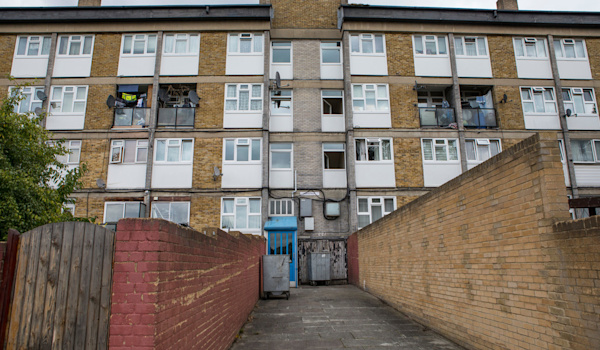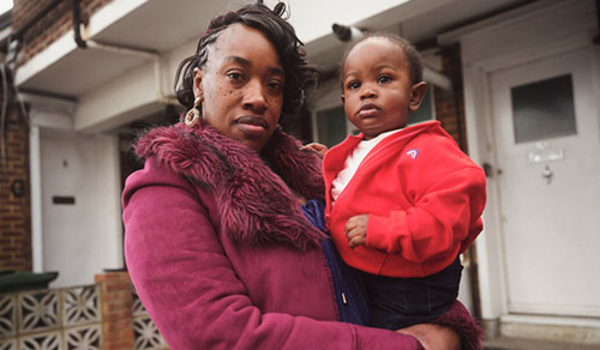The fight for home is a fight against racism
People of Colour are more likely to be homeless, live in deprived neighbourhoods and poor quality homes.
Racism in our housing system
The housing emergency in England shows itself most acutely in the inequalities it perpetuates.
In our 2021 survey on the conditions of people’s living situations, we found that Black and Asian people are far more likely to be denied the right to a safe and secure home.
Where a third (33%) of White households fell into this category, for those from a Mixed ethnic background and Asian households, this was half (49%); for Black households, this was more than half (56%).

What's causing structural racism in housing?
Our survey showed us that People of Colour were three to five times more likely to have experienced discrimination when looking for their current home. These results are unfortunately not a surprise.
Many families migrating to the UK at the end of the Second World War were discriminated against because of the colour of their skin; they were either refused housing or placed in lower-quality social housing*. Those who couldn’t access social housing were moved to poor-quality urban areas**.
Then, in the 1980s this inequality of access to social housing was made worse. The Right to Buy scheme resulted in an increase in ownership among White households and further reduced access for global majority ethnic groups. Furthermore, this period was the starting point for runaway house prices, which have resulted in unequal gains from ownership.
Discrimination continues because of racially focused policies such as No Recourse to Public Funds or Right to Rent, which has seen People of Colour discriminated against even when they are UK nationals.
With these historical and structural barriers to housing equality, it is no wonder that in the 2021 census, we saw that global majority ethnicities are less likely to be owner-occupiers in England, and more likely to be in insecure private rented housing than White British-led households.
* 'Dark Strangers: A Sociological Study of the Absorption of a Recent West Indian Migrant Group in Brixton, South London, Sheila Patterson (1963)
** ‘Housing and neighbourhoods: a European perspective’, in Race and Ethnicity in the 21st Century, Basingstoke: Palgrave Macmillan, Eds: A. Bloch and J. Solomos (2009)
2023-24 figures tell us that if you’re a Person of Colour you're much less likely to have a safe or secure home. 28% of people who seek help as they are homeless or at immediate risk of becoming homeless in England are Black (11%), Asian (7.5%), from a Mixed ethnic background (3.5%) or from an Other ethnic group (5.7%) - despite making up just 19% of households in the 2021 census.
Our analysis of government homelessness data found that Black-led households are 12 times more likely to be living in temporary accommodation than White-led households.
Black-led families facing homelessness are less than half as likely to secure a social home as their White counterparts (10% vs 24%)
In Scotland, where Black, Asian and other global majority groups make up just 5% of the total population, they are more likely to live in the private rental sector than the White majority population.
The fight against racism is fundamental to our purpose of defending the right to a safe home
Our latest posts on race and housing
Access to Shelter's Services for People of Colour
We want our services to be accessible to all. We commissioned a review of our services in England for People of Colour, with an anti-racist lens. The review sets out how we can continue to shape our services to ensure equity of access...Read on
The Fight for Home is a Fight Against Racism - statement
Everyone deserves an affordable, decent, and secure home. But historical inequities, modern policies and systemic racism mean that, while there is huge variation between different ethnic groups, People of Colour are disproportionately more likely to face the housing emergency...Read on
Right to Rent: entrenching discrimination in the private rented sector
Right to Rent was introduced as part of the Immigration Act of 2014. While originally intended to target people that don’t have permission to stay in the UK, the policy has embedded state-sanctioned discrimination, that encourages xenophobia and racism, within the private rented sector...Read on
Resources
We recognise that everyone is at a different point in their anti-racism journey. If you're not sure where to start, here are some resources you may find helpful.
Read
How to be an Anti-Racist by Ibram X Kendi
Natives by Akala
Why are People of Colour disproportionately impacted by the housing emergency? (Shelter blog)
Denied the right to a safe home (Shelter report)
Listen
How to be an anti-racist (podcast)
About Race (podcast)
Follow
Glossary of words on this page
People of Colour
People of Colour (or PoC) is a term used to refer to anyone who does not identify as White.
Global majority ethnicities
Global majority ethnicities refers to people who are Black, Asian, Brown, dual-heritage, indigenous to the global south, and or have been racialised as 'ethnic minorities'. It speaks to and encourages those so-called to think of themselves as belonging to the global majority.
Anti-racism
Anti-racism is the proactive dismantling of systemic racism and racist policies underpinning the White privileged society in which we exist. It addresses the specific harm and impact of racism on all racially marginalised communities and proposes equality of outcome, not just opportunity.
For Shelter, this means recognising how race directly impacts the experience and outcomes of our staff and clients, whether positively or negatively, and acknowledging the role power plays, who has it and how it's used.
Structural & Systemic racism
Structural racism
A system in which public policies, institutional practices and cultural representations reinforce ways to perpetuate racial inequity. It includes dimensions of history and culture that have allowed privileges associated with ‘Whiteness’ and disadvantages associated with ‘People of Colour’ to endure and adapt over time.
Structural racism is not something that a few people or institutions choose to practice. Instead, it has been and still is a feature of the social, economic and political systems in which we all exist.
Systemic racism
This refers to the way racism is built into every level of our society. One difference between the terms is that structural racism analysis pays more attention to the historical, cultural and social psychological aspects of our currently racialised society. Systemic racism refers to the way racism is built right into every level of our society.
More that may interest you

Anti-racism at Shelter


